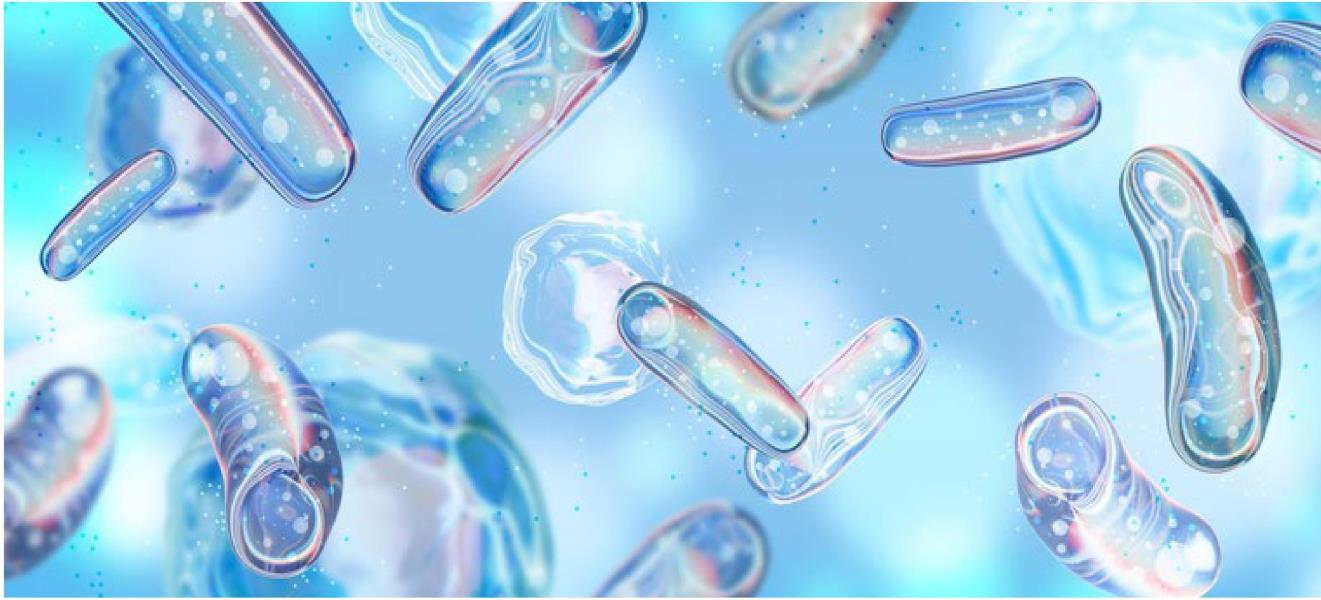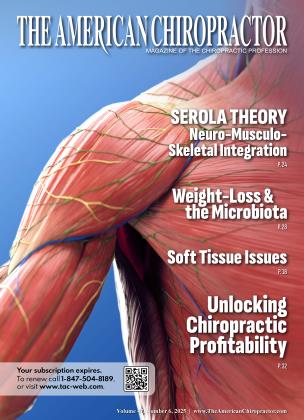
Consider your patient population. Tom has a tubby tummy, Heidi has hippo hips, and Ellen is just as big as an elephant. They all have tried one weight loss scheme (scam) after another, with nothing but frustration. You can help them.
You must understand there is one hidden force creating a barrier to weight loss — an evil controller operating from deep within to derange metabolic utilization of fat and carbohydrates for either energy production or for adipose storage. That barrier to metabolic control is constructed by a family of nasty critters dominating the gut microbiota.1,2,3,4
You and your patients must fully appreciate the far-reaching effects of the microbiota on metabolism. Gut microbes, for better or worse, exert powerful control over all metabolic processes. These wee beasties have direct communication lines
over which they influence the assimilation and destination of macronutri ents.4’5-6’7’8-9 They operate via:
• The Microbiota-Gut-Adipose Axis
• The Microbiota-Gut-Liver Axis
• The Microbiota-Gut-Pancreas Axis
• The Microbiota-Gut-Muscle Axis
• The Microbiota-Gut-Hypothalamus Axis.
The barriers created by bad bugs in the gut will stymie even the most sensible weight loss efforts. Shedding gobs of adipose certainly requires more than purging the bad guys and infusing a probiotic army of metabolic saviors, but as Tom, Heidi, and Ellen will testify, no diet will work until that is achieved.
There is a complex interplay of gut microbiota and host metabolism in regulation of efficient metabolism versus weight gain. It all begins in infancy. In fact, it begins with an infant’s “first meal” during birth.
As the baby slides down the birth canal, its entire body is coated with the mother’s microbiota. That implantation sows the seeds for that infant’s microbiome balance (or imbalance), which will tend to persist for life. Fortunately, that microbiota is modifiable by dietary and synbiotic (probiotic and prebiotic) supplementation throughout childhood and into adulthood.2,310
Bacterial balance in the microbiota of children who are overweight differs from those who are normal weight. The two fundamental imbalances driving toward childhood obesity are an elevated ratio between the Firmicutes to Bacteroidetes phyla, along with lower microbiota diversity. Surprisingly, one of the major offenders of the excess Firmicutes phylum is a certain species of the Lactobacillus genus — the ubiquitous Lactobacillus acidophilus. The natural microbiota of infants includes very little L. acidophilus, and that population vanishes almost entirely after the first year.1,10
“It is misconstrued that L reuteri is a causative factor in obesity. Quite the opposite is true.”
The link between the Firmicutes to Bacteroidetes ratio persists in overweight adults. Any effort to control excess weight gain must include a rebalancing of the gut microbiota. Clearly, the first step is to minimize Lactobacillus acidophilus (which precludes the use of probably 90% or more of all probiotic supplements).1,10
However, looking at the Firmicutes/Bacteroidetes ratio as an indicator of obesity risk can be misleading. It is not at all the case that high Firmicutes cause obesity and low Bacteroidetes help weight loss. Several Bacteroidetes species can induce weight gain.
The critical consideration is actually more related to an excess of certain genera among the Firmicutes phylum. In other words, do not be misled into thinking that you want to control weight by increasing Bacteroidetes. Many of the Bacteroidetes strains are responsible for elevating cholesterol and triglycerides, and others are associated with nonalcoholic fatty liver disease. No, your approach is to selectively cultivate a population of the beneficial Firmicutes species and eradicate the bad bacteria that encourage weight gain, while decreasing all the other inflammatory conditions they cause.1,3,10
This misconception about the Firmicutes!Bacteroidetes ratio can lead to false assumptions. Since L. reuteri, one of the most powerful anti-inflammatory probiotics, tends to be high in the microbiota of overweight individuals, it is misconstrued that L. reuteri is a causative factor in obesity. Quite the opposite is true.
Again, recall that transmission of information over the microbiota Gut-Adipose, -Liver, -Hypothalamus, and -Pancreas Axes goes two ways. An increase in L. reuteri is actually a defensive physiological attempt to mitigate the anti-metabolites produced by dysbiosis.10
You must remain cognizant that weight gain is an inflammatory process, and there is constant communication between adipose tissue and the gut. That communication line networks with the Gut-Hypothalamus Axis, the Gut-Liver Axis, and the Gut-Pancreas Axis. One of the primary benefits of a healthy microbiota is the production of short chain fatty acids (SCFA).
The most important SCFA is butyrate, which enhances metabolism by increasing mitochondrial activity and prevents formation of endotoxins. It is powerfully anti-inflammatory, both within the gut and via its influences through the Gut-Immune Axis. Lactobacillus reuteri is among the probiotic species yielding the most butyrate.4,10
L. reuteri is powerfully anti-inflammatory through several mechanisms including the production of butyrate. Regarding fat metabolism, it is specifically shown to benefit nonalcoholic fatty liver disease and to decrease elevated blood cholesterol. L reuteri improves insulin resistance, minimizes endotoxin, improves intestinal barrier function, and increases the hormone GLP-1, which is essential for weight loss. L. reuteri perfectly exemplifies the misunderstanding among many alternative healthcare practitioners who continue to recommend probiotic supplements that include counterproductive species, such as L. acidophilus, while remaining ignorant of the true warriors in the “battle of the bulge.”11
Also essential to weight loss are several species of Bifidobacterium. Compared to a control group, overweight subjects supplemented with Bifidobacterium breve significantly reduced percent body fat and body fat mass and decreased triglyceride levels and improved HDL cholesterol.11
Subjects with a BMI greater than 25 but less than 30 were supplemented with B. breve for 12 weeks during which they were instructed not to change their eating or exercise habits. Compared to the control group, the test group significantly decreased waist circumference, hip circumference, body fat mass (particularly visceral fat), and BMI. B. breve supplementation also increased glucagon-like peptides and proglucagon expression in the intestine, and adiponectin expression in the B-epiticular fat pad, both of which are effective in preventing obesity and insulin resistance.12
Participants with a BMI greater than 23 and less than 30 were supplemented with B. longum and B. breve for 16 weeks. Compared to the control group, participants showed a significant decrease in abdominal fat, serum triglycerides, and BMI. It is also noted that the probiotic supplementation improved intestinal barrier function, and decreased endotoxin. Inflammatory markers known to induce excess fat accumulation or insulin resistance were also decreased.13
The probiotic species most powerfully removing the barriers to weight loss include not only L. reuteri, B. breve, and B. longum, but also Lactobacillus rhamnosus, Lactobacillus gasseri, Lactobacillus casei, and Lactobacillus planterum. The benefits of these probiotics in weight loss are facilitated by the addition of prebiotics, including particularly Inulin FOS and Glucomannan.1
You can easily break down the bad bug barrier to weight loss. Exterminate those evil critters lurking in the darkness while building an army of microbiota warriors fighting to control fat metabolism. All you need is specificity in probiotic supplementation. Tom, Heidi, and Ellen are desperate for your help.

Dr. Guy Schenker, a Pennsylvania Chiropractor since 1978, developed the Nutri-Spec System of Clinical Nutrition, which eschews symptom-based nutrition in favor of individualized metabolic therapy. Reach us at 800-736-4320, or you can email us at [email protected], or visit Nutri-Npec.net.
References
1. Geng J, Ni Q, Sun W, Li L, Feng X. The links between gut microbiota and obesity and obesity related diseases. Biomed Pharmacother. 2022 Mar; 147:112678. doi: 10.1016/j.biopha.2022.112678. Epub 2022 Feb 5. PMID: 35134709.
2. Rafiq T, Stearns JC, Shanmuganathan M, Azab SM, Anand SS, Thabane L, Beyene J, Williams NC, Morrison KM, Teo KK, Britz-McKibbin P, de Souza RJ. Integrative multiomics analysis of infant gut microbiome and serum metabolome reveals key molecular biomarkers of early onset childhood obesity. Heliyon. 2023 May 30;9(6):el6651. doi: 10.1016/j.heliyon.2023.el6651. PMID: 37332914; PMCID: PMC 10272340.
3. Cerdo T, Garcia-Santos J A, G Bermudez M, Campoy C. The role of probiotics and prebiotics in the prevention and treatment of obesity. Nutrients. 2019 Mar 15; 11 (3):63 5. doi: 10.3390/null030635. PMID: 30875987; PMCID: PMC6470608.
4. Xiao H, Kang S. The role of the gut microbiome in energy balance with a focus on the gut-adipose tissue axis. Front Genet. 2020 Apr 7;11:297. doi: 10.3389/fgene.2020.00297. PMID: 32318095; PMCID: PMC7154186.
5. Yin Y, Guo Q, Zhou X, Duan Y, Yang Y, Gong S, Han M, Liu Y Yang Z, Chen Q, Li F. Role of brain-gut-muscle axis in human health and energy homeostasis. Front Nutr. 2022 Oct 6;9:947033. doi: 10.3389/fnut.2022.947033. PMID: 36276808; PMCID: PMC9582522.
6. Tilg H, Adolph TE, Trauner M. Gut-liver axis: Pathophysiological concepts and clinical implications. Cell Metab. 2022 Nov l;34(ll):1700-1718. doi: 10.1016/j.cmet.2022.09.017. Epub 2022 Oct 7. PMID: 36208625.
7. Konrad D, Wueest S. The gut-adipose-liver axis in the metabolic syndrome. Physiology (Bethesda). 2014 Sep;29(5):304-13. doi: 10.1152/physiol.00014.2014. PMID: 25180260.
8. Svegliati-Baroni G, Patricio B, Lioci G, Macedo MP, Gastaldelli A. Gut-pancreas-liver axis as a target for treatment of NAFLD/ NASH, hit J Mol Sei. 2020 Aug 13;21(16):5820. doi: 10.3390/ ijms21165820. PMID: 32823659; PMCID: PMC7461212.
9. Chen LH, Chang SS, Chang HY, Wu CH, Pan CH, Chang CC, Chan CH, Huang HY. Probiotic supplementation attenuates age-related sarcopenia via the gut-muscle axis in SAMP8 mice. J Cachexia Sarcopenia Muscle. 2022 Feb;13(l):515-531. doi: 10.1002/jcsm. 12849. Epub 2021 Nov 11. PMID: 34766473; PMCID: PMC8818665.
10. Crovesy L, Ostrowski M, Ferreira DMTP, Rosado EL, Soares-Mota M. Effect of Lactobacillus on body weight and body fat in overweight subjects: a systematic review of randomized controlled clinical trials, hit J Obes (Lond). 2017 Nov;41(ll):1607-1614. doi: 10.1038/ijo.2017.161. Epub 2017 Jul 10. PMID: 28792488.
11. Minami J, Iwabuchi N, Tanaka M, Yamauchi K, Xiao JZ, Abe F, Sakane N. Effects of Bifidobacterium breve B-3 on body fat reductions in pre-obese adults: a randomized, double-blind, placebo-controlled trial. Biosci Microbiota Food Health. 2018;37(3):6775. doi: 10.12938/bmfh.l8-001.Epub2018May 8. PMID: 30094122; PMCID: PMC6081611.
12. Sung HK, Youn SJ, Choi Y, Eun SW, Shin SM. Reply to Lee, SY. Comment on “Sung et al. Body fat reduction effect of Bifidobacterium breve B-3: a randomized, double-blind, placebo comparative clinical trial. Nutrients 2023, 15, 28”. Nutrients. 2023 Feb 22;15(5):1094. doi: 10.3390/nul5051094. PMID: 36904095; PMCID: PMC10005205.
13. Sato S, Arai S, Kato K, Yoshida K, Iwabuchi N, Sagami T, Tanaka M. Effects of Bifidobacterium longum BB536 and Bifidobacterium breve MCC1274 on body composition in normal and overweight adults in randomized placebo-controlled study. Nutrients. 2024 Mar 13; 16(6):815. doi: 10.3390/nul6060815. PMID: 38542727; PMCID: PMC10974859.
 View Full Issue
View Full Issue






